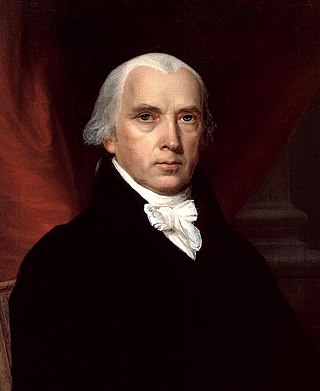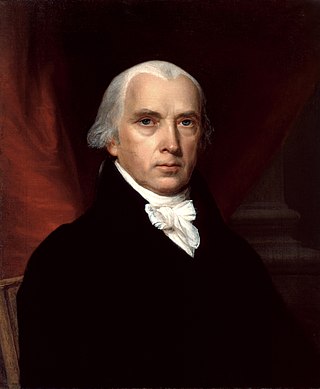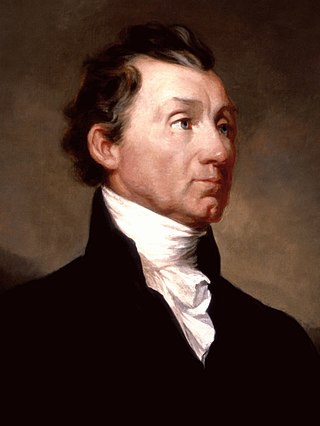Related Research Articles

The 1996 United States presidential election was the 53rd quadrennial presidential election, held on Tuesday, November 5, 1996. Incumbent Democratic President Bill Clinton defeated former Senate Majority Leader Bob Dole, the Republican nominee, and Ross Perot, the Reform Party nominee and 1992 Independent presidential candidate.

The 1792 United States presidential election was the second quadrennial presidential election. It was held from Friday, November 2, to Wednesday, December 5, 1792. Incumbent President George Washington was elected to a second term by a unanimous vote in the electoral college, while John Adams was re-elected as vice president. Washington was essentially unopposed, but Adams faced a competitive re-election against Governor George Clinton of New York.

The 1796 United States presidential election was the third quadrennial presidential election of the United States. It was held from Friday, November 4 to Wednesday, December 7, 1796. It was the first contested American presidential election, the first presidential election in which political parties played a dominant role, and the only presidential election in which a president and vice president were elected from opposing tickets. Incumbent vice president John Adams of the Federalist Party defeated former secretary of state Thomas Jefferson of the Democratic-Republican Party.

The 1804 United States presidential election was the fifth quadrennial presidential election, held from Friday, November 2, to Wednesday, December 5, 1804. Incumbent Democratic-Republican president Thomas Jefferson defeated Federalist Charles Cotesworth Pinckney of South Carolina. It was the first presidential election conducted following the ratification of the Twelfth Amendment to the United States Constitution, which reformed procedures for electing presidents and vice presidents.

The 1808 United States presidential election was the sixth quadrennial presidential election, held from Friday, November 4, to Wednesday, December 7, 1808. The Democratic-Republican candidate James Madison defeated Federalist candidate Charles Cotesworth Pinckney decisively.

The 1812 United States presidential election was the seventh quadrennial presidential election. It was held from Friday, October 30, 1812, to Wednesday, December 2, 1812. Taking place in the shadow of the War of 1812, incumbent Democratic-Republican President James Madison defeated DeWitt Clinton, the lieutenant governor of New York and mayor of New York City, who drew support from dissident Democratic-Republicans in the North as well as Federalists. It was the first presidential election to be held during a major war involving the United States.

The 1820 United States presidential election was the ninth quadrennial presidential election. It was held from Wednesday, November 1, to Wednesday, December 6, 1820. Taking place at the height of the Era of Good Feelings, the election saw incumbent Democratic-Republican President James Monroe win re-election without a major opponent. It was the third and the most recent United States presidential election in which a presidential candidate ran effectively unopposed. As of 2024, this is the most recent presidential election where an incumbent president was re-elected who was neither a Democrat nor a Republican, before the Democratic-Republican party split into separate parties. James Monroe's re-election marked the first time in U.S. history that a third consecutive president won a second election. This happened again with Barack Obama's re-election in the 2012 election and at no other point have multiple consecutive presidents won two elections.

The 1824 United States presidential election was the tenth quadrennial presidential election. It was held from Tuesday, October 26 to Thursday, December 2, 1824. Andrew Jackson, John Quincy Adams, Henry Clay and William Crawford were the primary contenders for the presidency. The result of the election was inconclusive, as no candidate won a majority of the electoral vote. In the election for vice president, John C. Calhoun was elected with a comfortable majority of the vote. Because none of the candidates for president garnered an electoral vote majority, the U.S. House of Representatives, under the provisions of the Twelfth Amendment, held a contingent election. On February 9, 1825, the House voted to elect John Quincy Adams as president, ultimately giving the election to him.

Each of the 50 U.S. states, the District of Columbia, and territories of the United States holds either primary elections or caucuses to help nominate individual candidates for president of the United States. This process is designed to choose the candidates that will represent their political parties in the general election.
The congressional nominating caucus is the name for informal meetings in which American congressmen would agree on whom to nominate for the presidency and vice presidency from their political party.

The election of the president and the vice president of the United States is an indirect election in which citizens of the United States who are registered to vote in one of the fifty U.S. states or in Washington, D.C., cast ballots not directly for those offices, but instead for members of the Electoral College. These electors then cast direct votes, known as electoral votes, for president, and for vice president. The candidate who receives an absolute majority of electoral votes is then elected to that office. If no candidate receives an absolute majority of the votes for president, the House of Representatives elects the president; likewise if no one receives an absolute majority of the votes for vice president, then the Senate elects the vice president.
In the United States, a contingent election is used to elect the president or vice president if no candidate receives a majority of the whole number of electors appointed. A presidential contingent election is decided by a special vote of the United States House of Representatives, while a vice-presidential contingent election is decided by a vote of the United States Senate. During a contingent election in the House, each state delegation votes en bloc to choose the president instead of representatives voting individually. Senators, by contrast, cast votes individually for vice president.

Electoral history of John Adams, who had served as the second president of the United States (1797–1801) and the first vice president of the United States (1789–1797). Prior to being president, he had diplomatic experience as the second United States envoy to France (1777–1779), the first United States minister to the Netherlands (1782–1788), and the first United States minister to the United Kingdom (1785–1788). After losing the 1800 presidential election to Thomas Jefferson, he would mostly retire from political life, with his second youngest son, John Quincy Adams (1767–1848), being elected as the sixth President of the United States (1825–1829) in the 1824 presidential election against Tennessee Senator Andrew Jackson.
References
- ↑ Southwick (1998), pp. 12–13
- 1 2 "Electoral College Box Scores 1789–1996". National Archives and Records Administration. Retrieved 16 September 2018.
- ↑ Akers 2002, pp. 29–30.
- 1 2 3 4 5 Regions are listed as defined by the United States Census Bureau.
"United States Presidential Election Results". Dave Leip's Atlas of U.S. Presidential Elections. Retrieved 16 September 2018.
"Electoral Votes, by State". U.S. Electoral College. National Archives and Records Administration. Retrieved October 27, 2019. - 1 2 Morgan (1969), pp. 185–186
- ↑ "Faithless Electors". FairVote. Archived from the original on February 9, 2021. Retrieved October 25, 2019.
- ↑ Chambers, William Nisbet (1963). Political Parties in a New Nation.
- ↑ Morgan (1969), pp. 191–193
- ↑ Siry (1985), pp. 457–460
- ↑ Deskins et al. (2010), pp. 65
- 1 2 3 4 5 6 7 8 Cook, Rhodes (October 27, 2016). "AN HISTORICAL RARITY: A FOUR-PARTY PRESIDENTIAL ELECTION". Sabato's Crystal Ball.
- 1 2 Rudner, Jordan (November 8, 2016). "All the ways the 2016 campaign made history". The Dallas Morning News.
- ↑ Feller, Daniel. "Andrew Jackson". Miller Center. University of Virginia. Retrieved October 26, 2019.
- ↑ Remini 2002, pp. 84–85.
- 1 2 3 4 5 "Presidential Firsts, Mosts and Almosts; Who was the first U.S. President? Herewith, a collection of facts and figures about the Presidency, Presidents, Presidential contenders and campaigns". New York Times. May 24, 1964.
- ↑ "James K. Polk: Campaigns and Elections". Miller Center of Public Affairs, University of Virginia. Retrieved April 28, 2017.
- ↑ Theisen (1971), p. 383
- 1 2 Rudin, Ken (22 July 2009). "When Has A President Been Denied His Party's Nomination?". NPR. Retrieved 9 February 2017.
- ↑ Freehling, William. "John Tyler: Campaigns and Elections". Miller Center. University of Virginia. Retrieved October 26, 2019.
- ↑ Jividen, Jason (May 7, 2012). "Ask a Scholar: Declining the Second Term". National Association of Scholars.
- ↑ "Ranking past presidents from least to most experienced". Northwest Indiana Times. December 2, 2017.
- ↑ Holt (2010), pp. 91–94
- ↑ McPherson (1988), pp. 140–144, 153–154
- ↑ Cooper, William. "James Buchanan: Campaigns and Elections". Miller Center. University of Virginia. Retrieved September 19, 2018.
- ↑ Boissoneault, Lorraine (January 26, 2017). "How the 19th-Century Know Nothing Party Reshaped American Politics". Smithsonian. Retrieved September 19, 2018.
- ↑ Hicks (1933), p. 10
- ↑ Gienapp (1985), p. 547
- ↑ History, .com. "Abraham Lincoln elected president". HISTORY. Retrieved 2022-06-03.
- ↑ Smith (1975), pp. 106–113
- ↑ VandeCreek, Drew E. "Campaign of 1860". Northern Illinois University Libraries. Retrieved September 19, 2018.
- ↑ Patch, B. W. (1936). "Third Party Movements in American Politics". CQPress. Retrieved 19 September 2018.
- ↑ Rosenstone et al. (2018), pp. 59–63
- ↑ Hicks (1933), pp. 3–28
- ↑ Burlingame, Michael. "Abraham Lincoln: Campaigns and Elections". Miller Center. University of Virginia.
- 1 2 3 4 "Women Presidential and Vice Presidential Candidates: A Selected List". Center for Women and American Politics. Rutgers University. Retrieved October 25, 2019.
- ↑ Faber & Bedford (2008), p. 81
- ↑ "The Third Term Tradition in American Politics". CQ Press. March 19, 1927.
- ↑ Rakich, Nathaniel (February 11, 2019). "Which Offices Are Good Stepping Stones To The Presidency?". FiveThirtyEight.
- ↑ Southwick (1998), pp. 102–103
- ↑ Brands 1997, pp. 513–14.
- ↑ Weeks, Linton (December 1, 2015). "A Forgotten Presidential Candidate From 1904". NPR.
- ↑ Huebner, Robin (February 1, 2016). "A place in history: In 1912, ND held nation's first ever presidential primary". The Dickinson Press.
- ↑ Haga, Chuck (March 10, 2008). "While no bellwether, N. Dakota once led in primary fever". MinnPost.
- ↑ Simon 2012 , pp. 95–99
- ↑ Slayton, Robert A. (2001). Empire statesman. Simon and Schuster. p. 304. ISBN 978-0-684-86302-3.
- ↑ Schlesinger Jr., Arthur (February 2, 1990). "O'Connor, Vaughan, Cuomo, Al Smith, J.F.K. - The New York Times" . Retrieved May 19, 2009.
- ↑ Burner 1996, p. 4.
- ↑ Beschloss, Michael (August 29, 2015). "Before Trump or Fiorina, There Was Wendell Willkie". New York Times.
- ↑ Smith (1982), pp. 401–425
- ↑ The New York Times, November 20, 1960, Section 4, p. E5
- ↑ Eckstein, Megan (March 9, 2015). "From Ensign to Commander-in-Chief: A Look at the Presidents Who Served in the U.S. Navy Reserve". USNI News.
- ↑ "2 pioneers in black history". IndyStar. February 16, 2015.
- ↑ Rozsa, Matthew (2019-07-12). "There are four presidential candidates of Jewish descent — the most ever. Does it matter?". Salon. Retrieved 2024-03-30.
- ↑ Krieg, Gregory (2016-02-05). "Bernie Sanders is first Jewish candidate to win a primary. Does he care? | CNN Politics". CNN. Retrieved 2024-03-30.
- ↑ Linthicum, Leslie (2007-02-07). "Richardson Not Quite the First". Albuquerque Journal . Albuquerque Journal. Retrieved 2012-12-06.
- ↑ Best, Kenneth (January 26, 2016). "A Candidate Like Me: Historic Firsts in U.S. Politics". University of Connecticut.
- ↑ Andrews, Evan (August 31, 2018). "Election 101: Who was the first woman to run for president?". History.com.
- ↑ Bernard Weinraub (October 17, 1988). "Campaign Trail; Tapping Another Ethnic Group". The New York Times . Retrieved August 24, 2008.
- ↑ "Visiting Israel, US Jewish senator Joe Lieberman connects you to Shabbat". The Jerusalem Post. 2021-10-13. Retrieved 2024-03-14.
- ↑ "Barack Obama elected as America's first black president". History. A&E Television Networks. July 28, 2019. Retrieved October 27, 2019.
- ↑ Farley, Robert (May 12, 2008). "Was McCain born in the USA?". Politifact.
- ↑ Gorman, Michele (August 5, 2016). "FEMALE U.S. PRESIDENTIAL CONTENDERS BEFORE HILLARY CLINTON IN 2016". Newsweek.
- ↑ Somashekhar, Sandhya; Horowitz, Jason (May 29, 2012). "Mitt Romney's nomination marks milestone for Mormon faith". Washington Post.
- ↑ Brooks, Ryan C. (April 2, 2019). "Pete Buttigieg Is Not The First Openly Gay, Major Party Presidential Candidate. This Guy Was". BuzzFeed News.
- ↑ Pino, Faith E. (May 31, 2019). "Pete Buttiegig's run as an openly gay presidential candidate has roots in Laguna Beach". Los Angeles Times.
- ↑ Graham, Ruth (December 22, 2016). "The Strange History of Faithless Electors Casting Their Votes for Women". Slate.
- 1 2 3 "Which candidates did the seven "faithless" electors support?". www.cbsnews.com. Retrieved 2020-08-13.
- ↑ Begley, Sarah (December 20, 2016). "Hillary Clinton Leads by 2.8 Million in Final Popular Vote Count". Time . Retrieved December 21, 2018.
- ↑ Funk, Tim (February 20, 2016). "10 firsts in the race for president: First woman, first Hispanic, first billionaire among field". The Charlotte Observer.
- ↑ "Louisiana Gov. Bobby Jindal Becomes First Asian-Indian to Run for President". Fox News. Archived from the original on 2015-06-26. Retrieved 25 June 2015.
- ↑ Alex Altman (1 March 2020). "Pete Buttigieg's History-Making Campaign Fell Short, But He Leaves the Race a Star". Time . Retrieved 2 March 2020.
- ↑ "Hawaii Rep. Tulsi Gabbard Drops Presidential Bid, Endorses Biden". March 19, 2020.
- ↑ "Indian-American Nikki Haley suspends her Republican presidential campaign says 'no regrets'". The Week. No. PTI. 6 March 2024. Retrieved 2 June 2024.
- ↑ Gamio, Lazaro; Yourish, Karen; Haag, Matthew; Bromwich, Jonah E.; Haberman, Maggie; Lai, K.K. Rebecca (May 30, 2024). "The Trump Manhattan Criminal Verdict, Count By Count". The New York Times. Archived from the original on May 30, 2024. Retrieved May 30, 2024.
- ↑ "Takeaways from the final night of the Republican National Convention". CNN . July 19, 2024. Retrieved July 22, 2024.
Works cited
- Akers, Charles W. (2002). "John Adams". In Graff, Henry (ed.). The Presidents: A Reference History (7th ed.). New York City: Charles Scribner's Sons. pp. 23–38. ISBN 0-684-80551-0.
- Brands, Henry William (1997), TR: The Last Romantic (full biography), New York: Basic Books, ISBN 978-0-465-06958-3, OCLC 36954615
- Burner, David (1996) [1979]. Herbert Hoover: The Public Life. Easton Press. Originally published as Burner, David (1979). Herbert Hoover: The Public Life. Knopf Doubleday. ISBN 978-0-394-46134-2.
- Cooper, John Milton Jr. (2009). Woodrow Wilson. Knopf Doubleday Publishing Group. ISBN 9780307273017.
- Deskins, Donald Richard; Walton, Hanes; Puckett, Sherman (2010). Presidential Elections, 1789–2008: County, State, and National Mapping of Election Data. University of Michigan Press. ISBN 978-0472116973.
- Faber, Richard B.; Bedford, Elizabeth A. (2008). Domestic Programs of the American Presidents: A Critical Evaluation . McFarland. ISBN 9780786431830.
- Gienapp, William E. (1985). "Nativism and the Creation of a Republican Majority in the North before the Civil War". The Journal of American History. 72 (3): 529–555. doi:10.2307/1904303. JSTOR 1904303. S2CID 159570266.
- Hicks, John D. (1933). "The Third Party Tradition in American Politics". The Mississippi Valley Historical Review. 20 (1): 3–28. doi:10.2307/1902325. JSTOR 1902325.
- Holt, Michael F. (2010). Franklin Pierce. Times Books. ISBN 978-0-8050-8719-2.
- McPherson, James M. (1988). Battle Cry of Freedom: The Civil War Era. Oxford University Press. ISBN 9780199743902.
- Morgan, William G. (1969). "The Origin and Development of the Congressional Nominating Caucus". Proceedings of the American Philosophical Society. 113 (2): 184–196. JSTOR 985965.
- Remini, Robert V. (2002). John Quincy Adams. New York: Times Books. ISBN 0-8050-6939-9.
- Rosenstone, Steven J.; Behr, Roy L.; Lazarus, Edward H. (2018). Third Parties in America: Citizen Response to Major Party Failure (2nd ed.). Princeton University Press. ISBN 9780691190525.
- Simon, James F. (2012). FDR and Chief Justice Hughes: The President, the Supreme Court, and the Epic Battle Over the New Deal. Simon & Schuster. ISBN 978-1416573289.
- Smith, Richard Norton. Thomas E. Dewey and His Times. Simon & Schuster, (1982)
- Smith, Elbert B. (1975). The Presidency of James Buchanan . University Press of Kansas. ISBN 978-0-7006-0132-5.
- Theisen, Lee Scott (1971). "James K. Polk, Not So Dark a Horse". Tennessee Historical Quarterly. 30 (4): 383–401. JSTOR 42623261.